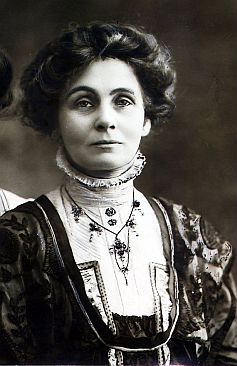The Right to Vote, Women’s Suffrage, and Tumultuous Petitions
By Ben Darlow
Published on June 4, 2017

The UK’s General Election on 8 June 2017 provides a compelling backdrop for a discussion of the history of voting rights in Parliamentary elections. In particular, the struggle of women to obtain the right to vote holds a unique place in English Legal History and is worthy of discussion.
Following the Battles of Lewes in 1264 and the defeat of royal forces, Simon de Montfort (Earl of Leicester) brought together the English Parliament of 1265 consisting of, amongst others, two representatives (Knights) from each County, with the insistence that such representatives be elected. Although de Montfort was killed at the Battle of Evesham later in 1265, the idea of elected Members of Parliament persisted.
In the following two centuries, there is some debate surrounding who could exercise the right to vote in the Counties, although it is probable that all house owners resident in the County could do so, both male and female. This state of affairs continued until the implementation of the Electors of Knights of the Shire Act 1432 by Henry VI (reciting and reiterating an earlier Act of 1430) which stated that only landowners whose land attracted an annual rent of at least £2 were eligible to vote in Parliamentary elections. Although the 1432 Act did not limit the vote to men, male-only voting became customary as an extension of the social norm of men being perceived to be best placed to protect women’s interests.
Those who owned land in multiple Counties with the required value of £2 could vote multiple times, providing a powerful election tool for the wealthy landowners of the time. It was not until the Representation of the People Act 1832 that the right to vote was explicitly restricted to men, specifying ‘male persons’ in the Act itself. The 1832 Act restricted the vote to men who occupied land to the value of £10 which excluded approximately 85% of men and, of course, 100% of women. In 1780, only 214,000 people in England had the right to vote which was only 3% of the total population of 8,000,000. This number had only increased to 366,000 by 1831. The 1832 reforms did little to change the situation. Further Representation of the People Acts in 1867 and 1884 substantially increased the number of voters by extending male suffrage to all house owners. This still did not achieve universal male suffrage.
In the intervening centuries, some wealthier women landowners had voted in Parliamentary elections and there is evidence of such women appointing male proxies to vote on their behalf. Great publicity was made of the restrictions of the 1832 Act when, in 1867, Lily Maxwell voted in her local Parliamentary by-election. Ms Maxwell had been entered on the electoral register by mistake as she met the property value requirements. Ms Maxwell’s vote was later declared illegal by the Court of Common Pleas.
Although women’s suffrage was a political topic before and after 1832 Act (with the influential jurist Jeremy Bentham calling for the right to vote for women in 1817), the National Society for Women’s Suffrage was not established until 1872 and the eventually more militant organisation of the Women’s Social and Political Union was established by the Pankhursts in 1903.
Despite being well known for militant action, the suffragettes had carried out a great number of peaceful attempts to publicise the struggle for women’s suffrage. The militant action was largely in response to these peaceful attempts being ignored and undermined by men in power. Two of these peaceful attempts in particular are fascinating highlights in English Legal History.
Firstly, in 1908, a Mr Muskett was successfully prosecuting a group of suffragettes in the Westminster Police Court. The group were sentenced to two months in prison and a £5 fine, a common punishment that was levied many times against the suffragettes. Mr Muskett warned the group that if they offended again, he would seek to use the long dormant Tumultuous Petitioning Act 1661 against them. The 1661 Act was a remnant from the time of Charles II and stated that a group of no larger than 10 people were allowed to petition the monarch or the House of Commons. If a group larger than 10 did so, they were liable to a sentence of 3 months in prison. The 1661 Act was a response to the many violent petitions brought outside the House of Commons towards the climax of the English Civil War in 1651 and which led to the execution of Charles I. The right to petition the Monarch and the House of Commons is a long established right in English Legal History and stretches back at least to the time of Henry III in the 13th Century.
The right to petition in this way was enshrined in the Bill of Rights 1689 which was seen by some as a de facto repeal of the 1661 Act. Unfortunately, the 1661 Act was not formally repealed until the implementation of the Public Order Act 1986.
Emmeline Pankhurst wished to test Mr Muskett’s assertion and the day after the successful prosecution above, she brought a group of 13 suffragettes to Parliament to petition. A prosecution under the 1661 Act would require a full trial before a jury (something the suffragettes desperately wanted as many members of the public were sympathetic to the cause of women’s suffrage), rather than a closed trial at the Police Court. Mrs Pankhurst was arrested on her approach to Parliament and tried in the Police Court. Sadly, no reference was ever made to the 1661 Act.
Secondly, much of the early suffragette work revolved around campaigning in areas where Parliamentary by-elections were taking place in an attempt to de-seat current Liberal Parliamentary members and upset the status quo. In 1908, a 34 year old Winston Churchill was promoted to the Government Cabinet by becoming the President of the Board of Trade. Any new Cabinet member had to go through a process of re-election to their constituency. Christabel Pankhurst and other suffragettes campaigned in Mr Churchill’s previously safe constituency of North West Manchester. Mr Churchill, to his shock, lost his seat to the Conservative William Joynson-Hicks by 429 votes. The day after the election, the Daily Telegraph carried the front page headline: “Winston Churchill is OUT! OUT! OUT!”.
Mr Churchill then sought election in the constituency of Dundee which was a Liberal Parliamentary stronghold seat that he would win without doubt. In any event, Emmeline Pankhurst sought to campaign against him and part of Mr Churchill’s response was to hold a women only event assuring the women of Dundee that he would seek women’s suffrage in the next Parliament. Mr Churchill won the seat. This must have proved an interesting early political tumult for a man who would go on to serve two terms as Prime Minister, one of those terms during the course of World War II.
Further campaigning and political pressure led to the introduction of the Representation of the People Act 1918 which granted the right to vote to all men, free from property value restrictions. The 1918 Act also granted voting rights to women over 30 years of age, albeit with the requirement of being a property owner. The Representation of the People Act 1928 (a mere 89 years ago) followed which granted voting rights to all men and women aged 21 and over (the then age of majority, rather than 18 as it is today), with no property ownership or value restrictions.
Interestingly, a 1948 Act of the same name abolished the English University constituencies. These were constituencies surrounding certain historic Universities (e.g. Oxford and Cambridge) and graduates of those Universities were allowed to vote both in the constituency where they resided and also in their University constituency, thereby voting twice in the same election. The 1948 Act put an end to this last vestige of multiple voting. Finally, the Representation of the People Act 1969 extended the right to vote to those aged 18 to 20 years old.
As an attempt at further Parliamentary Election reform, the Labour minority Government of 1931 introduced a Representation of the People Bill which included a provision to switch from the First Past The Post voting system (the still current UK model) to a form of Alternative Vote. The Bill was successful at the voting stages in both the House of Commons and the House of Lords but the Labour Government was defeated in the 1931 General Election before the Bill could become law. A national referendum in 2011 asked the UK public whether or not they wanted to switch to the Alternative Vote system. The switch was rejected with 67.9% of the public answering ‘No’. In 2016, Green Party MP Caroline Lucas introduced into the House of Commons the Electoral Reform Bill with a provision to change voting in Parliamentary elections to a form of Proportional Representation which would assist the smaller political parties in achieving representation in Parliament. The Bill was rejected.
In the UK’s 2015 General Election, only 43% of those aged 18-24 years old voted in comparison to over 80% of those aged 65 and over. The very youngest adults of the UK have only had the right to vote for 48 years. It has certainly been a long and long fought over road across nearly 800 years of English Legal History to achieve the Parliamentary election and voting system the UK has today. Perhaps the voting turnout from the youngest in our society in the UK’s 2017 General Election on 8 June 2017 will make its own mark in English Legal History.
The Author

Ben Darlow is the author of the English Legal History blog and has an LLB (Hons) Law degree from the UK’s University of Leicester.
He has always had a healthy academic interest in, and fascination with, Legal History and established the English Legal History blog in April 2013 to bring that interest to a wider audience in an easy-to-digest and accessible format.
Article picture: Emmeline Pankhurst. Source: Wikipedia


